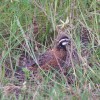 This 2-page fact sheet provides specific tips to improve quail habitat in cattle country that focus on diversifying the plant species and structural composition and increasing early successional communities dominated by herbaceous plants. Written by William M. Giuliano and Lauren Watine, and published by the UF Department of Wildlife Ecology and Conservation, January 2013.
This 2-page fact sheet provides specific tips to improve quail habitat in cattle country that focus on diversifying the plant species and structural composition and increasing early successional communities dominated by herbaceous plants. Written by William M. Giuliano and Lauren Watine, and published by the UF Department of Wildlife Ecology and Conservation, January 2013.
http://edis.ifas.ufl.edu/uw377
Tag: Wildlife and Agriculture
Insecticides and Wildlife (ENY511/IN881)
 When we use chemical insecticides to eliminate problem insects we discover that the effects of insecticides are not always limited to these 6-legged targets. Wildlife, pets, and humans also can be affected by insecticides. So one of the great challenges confronting humans is to develop ways to manage insects without affecting non-target organisms. Learn more in this 16-page fact sheet written by John L. Capinera, and published by the UF Department of Entomology and Nematology, October 2011.
When we use chemical insecticides to eliminate problem insects we discover that the effects of insecticides are not always limited to these 6-legged targets. Wildlife, pets, and humans also can be affected by insecticides. So one of the great challenges confronting humans is to develop ways to manage insects without affecting non-target organisms. Learn more in this 16-page fact sheet written by John L. Capinera, and published by the UF Department of Entomology and Nematology, October 2011.
http://edis.ifas.ufl.edu/in881
Farmer Perceptions of Wildlife Damage to Row Crops in North Florida (WEC311/UW356)
 How can we determine the just how much of an impact wildlife damage has on growers? This 4-page fact sheet presents the results of a survey of a sample of growers across the state. Written by Holly K. Ober, Gerald R. Edmondson, William M. Giuliano, David L. Wright, John Atkins, Andy Andreasen, Shep Eubanks, Libbie Johnson, Charles Brasher, and Greg Hicks, and published by the UF Department of Wildlife Ecology and Conservation, July 2011.
How can we determine the just how much of an impact wildlife damage has on growers? This 4-page fact sheet presents the results of a survey of a sample of growers across the state. Written by Holly K. Ober, Gerald R. Edmondson, William M. Giuliano, David L. Wright, John Atkins, Andy Andreasen, Shep Eubanks, Libbie Johnson, Charles Brasher, and Greg Hicks, and published by the UF Department of Wildlife Ecology and Conservation, July 2011.
http://edis.ifas.ufl.edu/uw356
Checklist of Birds of the Everglades Agricultural Area (CIR1444/UW179)
This revised 10-page fact sheet features a checklist of bird species that have been found during eight years of surveys in the Everglades Agricultural Area. Most birds can be associated with a specific habitat such as sugarcane, sod, rice or flooded fields and other agricultural and human-inhabited areas. Written by Elise V. Pearlstine and Frank J. Mazzotti, and published by the UF Department of Wildlife Ecology and Conservation, November 2010.
http://edis.ifas.ufl.edu/uw179